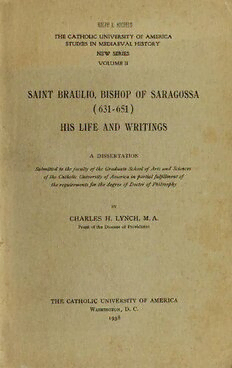
Saint Braulio, Bishop of Saragossa (631-651): His Life and Writings PDF
Preview Saint Braulio, Bishop of Saragossa (631-651): His Life and Writings
SAINT BRAULIO, BISHOP OF SARAGOSSA (631-651) HIS LIFE AND WRITINGS THE CATHOLIC UNIVERSITY OF AMERICA STUDIES IN MEDIAEVAL HISTORY NEW SERIES VOLUME II SAINT BRAULIO, BISHOP OF SARAGOSSA ( - ) 631 651 HIS LIFE AND WRITINGS A DISSERTATION Submitted to the faculty of the Graduate School of Arts and Sciences of the Catholic University of America in partialf ulfillment of the requirements for the degree of Doctor of Philosophy BY CHARLES H. LYNCH, M. A. Priest of the Diocese of Providence THE CATHOLIC UNIVERSITY OF AMERICA Washington, D. C. 1938 Jítíjtt obstat Aloysius K. Ziegler, S.T.D . Censor Deputatus Imprimatur Franciscus Patricius Keough, D.D. Episcopus Providentiensis Providentiae, die IV Martii, 1938 This dissertation was conducted under the direction of Aloysius K. Ziegler as Major Professor, and was approved by Martin R. P. McGuire, James A. Geary, and Ignatius Smith, O. P., as readers. COPYRIGHT, 1938 THE CATHOLIC UNIVERSITY OF AMERICA THE DOLPHIN PRESS Philadelphia Pennsylvania MY MOTHER AND FATHER PREFACE The seventh century of the Christian era was undeniably a dark age. No matter what the column one may consult in an historical chart of civilization from 500 B. C. on, the years 600- 700 A. D. are the least productive in names and events, both in the East and in the West. Of the countries in that period, the one that showed the most sustained intellectual effort was Spain. Civilization there was relatively far advanced due prin cipally to an internal solidarity of Hispano-roman and Visigoth, of Church and State, with the numerous Toledan church councils of a quasi-civil nature constituting the chief unifying force. Although one’s thoughts turn instinctively to St. Isidore of Seville as the individual responsible for this condition, the truth is that such an advance follows in the wake of many leaders. Some of the Visigothic kings played an enlightened part, but particularly it was the bishops who led: John of Biclar, John of Saragossa, Braulio, Eugene II, Tajo, Fructuosus, Ildefonse, and Julian. Among these bishops the figure of St. Braulio stands out in relief and he has been made the subject of the present study. This bishop of Saragossa, because of his innate ability and be cause of the prestige he enjoyed as the friend and counsellor of Isidore, should be considered second only to Isidore in his in fluence on the Spanish civilization of his century. Braulio suc ceeded Isidore as the outstanding figure in Spanish ecclesias tical and civil circles from 636-651. His influence extended beyond his death and was felt through the persons of leaders he had formed, notably Eugene II of Toledo and Tajo of Saragossa. A detailed study of Braulio’s life and writings should throw considerable light on his period. No one has ever essayed such vii vin Preface a study. Manuel Risco in the eighteenth century presented a creditable survey of both when in volume 30 of España sagrada he made available for the first time Braulio’s chief literary contribution, the entire corpus of his forty-four Letters. Since then scholars have often turned to Braulio’s writings and pointed out what is to be found in them on theology, liturgy, hagiography, political history and philosophy, literature, and biography, but never with the intention of presenting a sys tematic biography of Braulio, or a comprehensive study of his thought. They have always been absorbed in some other person or some particular thesis. Fidel Fita, for instance, in the last century wrote a valuable article on Braulio’s part in the relations between the Spanish Church and Rome at the time. Recently Dom Lambert made a very careful study of Braulio’s family, but his work was meant to confirm a thesis on the spread of the monastic Rule of John of Biclar. More recently Dorn Pérez de Urbel offered the first modern treatment of Braulio and his writings in the Dictionnaire d’histoire et de géographie ecclé siastiques, but the very limits of the article prevented a detailed study of the problems raised. Apart from the Letters, the only writings which can be ascribed to Braulio with certainty are his eulogy of Isidore and catalog of his works, called the Praenotatio librorum, D. Isidori, a Life of St. Emilian, and a Hymn in honor of the same saint. Other works claimed for him by some can in no one case be definitely ascribed to him, and, except for a study of their attri bution, do not come within the purview of this work. There is only one primary source worth mentioning for a study of the life of St. Braulio. It is the corpus of his Letters, which includes also those Letters written to him. The brief notice that Ildefonse devotes to him in his De viris illustribus and the few references that Eugene of Toledo has to Braulio’s family in his poems are almost negligible. He would have remained to this day hardly more than a name had not the greater number
